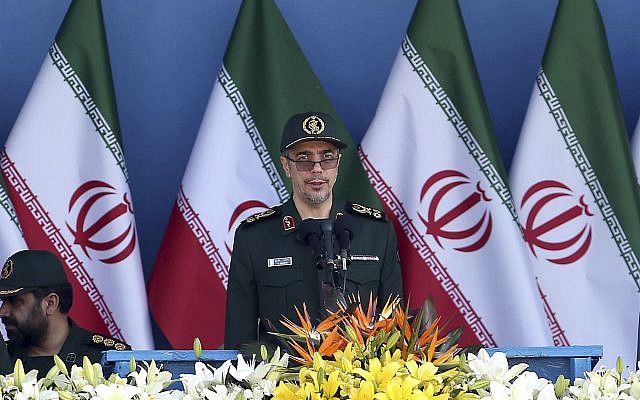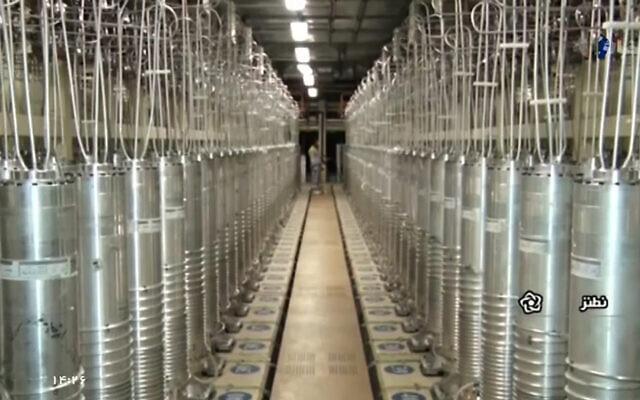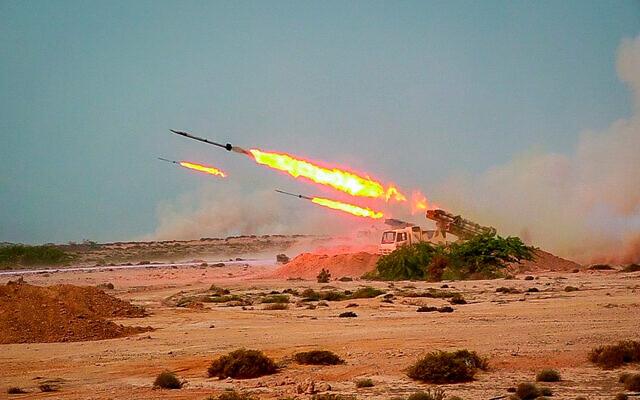- Armed forces chief says exercise is a response to Israel’s ‘massive but pointless threats’
Iran’s paramilitary Revolutionary Guard fired more than a dozen surface-to-surface ballistic missiles during an exercise this week, the official IRNA news agency reported on Friday.
The report said the Guards fired 16 missiles during an ongoing major military drill across the country’s South.
It said the missiles were of the models Emad, Ghadr, Sejjil, Zalzal, Dezful and Zolfaghar and that their range is from 350 to 2000 kilometers (220 to 1250 miles).
The short-range and medium-range missiles, Iran has said, can reach Israel as well as US bases in the region.
Iranian officials said the missiles fired during the drill successfully hit one target at the same time as 10 drones simultaneously hit their targets. State TV showed missiles launching in the desert. Get The Times of Israel’s Daily Edition by email and never miss our top stories Newsletter email address By signing up, you agree to the terms
Major General Mohammad Hossein Bagheri, the chief of staff of Iran’s Armed Forces, said the planned drill was an answer to Israel’s recent “massive but pointless threats” against Iran.
“This was a tiny part of hundreds of missiles that can hit any hostile target simultaneously,” he said. Chief of Staff of Iran’s Armed Forces, General Mohammad Hossein Bagheri delivers a speech just outside Tehran, Iran, on September 21, 2016. (AP Photo/Ebrahim Noroozi)
Chief of Staff of Iran’s Armed Forces, General Mohammad Hossein Bagheri delivers a speech just outside Tehran, Iran, on September 21, 2016. (AP Photo/Ebrahim Noroozi)
Bagheri further warned Israel against making the “slightest mistake,” according to Press TV.
Otherwise “we will cut off their hands,” Bagheri said, adding that a drill could be converted easily into a military operation. It’s just a “change in the angle of launching the missiles.”
During the second day of the drill on Tuesday, Iran launched cruise missiles, too.
The five-day annual exercise that began on Monday comes amid troubled talks in Vienna to revive Tehran’s nuclear deal with world powers. Iran has accelerated its nuclear advances as negotiations to return to the accord struggle to make headway. The talks will resume on Monday. Various centrifuge machines line a hall at the Natanz Uranium Enrichment Facility, on April 17, 2021. (screenshot, Islamic Republic Iran Broadcasting – IRIB, via AP)
Various centrifuge machines line a hall at the Natanz Uranium Enrichment Facility, on April 17, 2021. (screenshot, Islamic Republic Iran Broadcasting – IRIB, via AP)
Former president Donald Trump pulled the United States out of the nuclear deal and re-imposed crushing sanctions on Iran in 2018. Tehran has since started openly enriching uranium up to 60 percent purity — a short technical step from the 90% needed to make an atomic bomb.
Israel has long seen Iran’s nuclear program as a threat and seeks a harder line by the US and international community. Iran insists its nuclear program is peaceful.
Israel is not a party to the Vienna talks but has threatened force if diplomacy fails, and the US has also said it is preparing “alternatives.” Earlier this month, Defense Minister Benny Gantz said he notified US officials that he had instructed the Israel Defense Forces to prepare for a strike against Iran.
A senior US official said earlier this month that Israeli and American military leaders are set to discuss possible military drills to practice destroying Iranian nuclear facilities in a potential worst-case scenario if nuclear talks fail.
Israel has reportedly approved a budget of some NIS 5 billion ($1.5 billion) to be used to prepare the military for a potential strike against Iran’s nuclear program. It includes funds for various types of aircraft, intelligence-gathering drones and unique armaments needed for such an attack, which would have to target heavily fortified underground sites.





